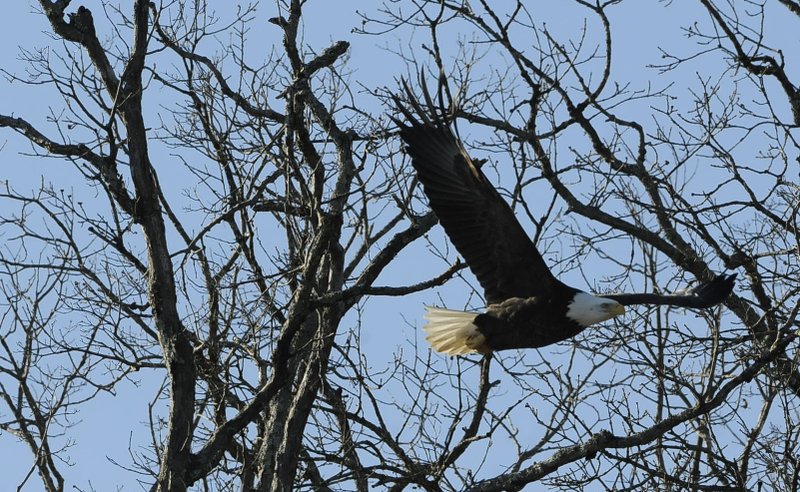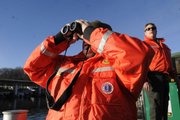Bald eagles are just one reason to get up from a comfy rocker by the hearth and bundle up for a wintertime boat ride on Beaver Lake.
Army Corps of Engineers Rangers are among the cold-weather cruisers on the lookout for eagles.
Get The Lead Out
Karen Rowe, wildlife biologist with the Arkansas Game & Fish Commission, said one-third of all bald eagle deaths are caused by eagles ingesting lead. They may swallow lead when feeding on the carcass of a deer that has been shot and not recovered, or may swallow a lead fishing sinker when feeding in shallow water. One small lead pellet can be fatal, she said.
Rowe encourages deer hunters and anglers to use nontoxic bullets and fishing weights. Rowe is a deer hunter herself and uses copper bullets in her hunting.
— Staff Report
Bald eagles fly south to the lake each fall and winter to avoid frozen water and snow up north. Just how many eagles winter on the reservoir from year to year is why Rangers pull on layers of clothes and head out on the lake each January to count them.
The effort lets wildlife officials know if the number of eagles is up or down at Beaver Lake as years pass. Similar eagle counts are held at Army Corps of Engineers lakes and other waterways around the nation. Results are reported to the U.S. Geological Survey and the U.S. Fish and Wildlife Service, said Alan Bland, park ranger at Beaver Lake. The count part of a national database to gauge the health of the bald eagle population over time, he added.
The count at Beaver Lake has been held each January for at least 30 years. That's how many years Bland has been part of the count crew. Rangers travel by boat from the headwaters of the lake near Fayetteville north to the dam near Eureka Springs looking for eagles.
This year's count was held Jan. 7. Bland, Ranger Brian Walch counted the north end of the lake from the Arkansas 12 bridge to the dam. Another crew headed south from the bridge. It takes all day to cover the entire lake, going into every arm and inlet.
The combined tally was 129 bald eagles -- 99 adult bald eagles and 30 juveniles. That's about average for the annual count, Bland said. Last year's numbers are incomplete because bad weather halted the effort in mid count.
"If the number shows a decline or a big rise we'd ask, 'Why is that?,'" Bland said. "If there's a decline we could possibly do something to stop it.
"The bald eagles here at Beaver Lake are doing extremely well. People see them all the time."
Eagles are faring well enough that there are now five bald eagle nests on the lake, from the headwaters to the dam. The southern-most nest is in the Pine Creek arm along the Washington-Benton county line. There is a nest in a cove between Prairie Creek and Rocky Branch parks and three nests near Beaver Dam.
Bland inspected the four northern-most nests on Jan. 7. All appeared to be in good shape. Young eagles were raised in the five nests last year, he said.
Wintertime Cruise
It's possible to see bald eagles anywhere on the lake. The best spots are creek arms such as Joe's Creek, Esculapia Hollow, Ford's Creek, Van Winkle Hollow and Indian Creek. These have remote habitat that eagles favor.
Most all eagles seen have migrated here from the Great Lakes region of the U.S., and south-central Canada. Five bald eagle nests on the lake mean there are a handful of resident bald eagles.
These residents may or may not migrate from the Beaver Lake area, said Karen Rowe, wildlife biologist with the Arkansas Game & Fish Commission.
In January, these resident eagles spruce up their nests by adding a few new sticks and maybe some grass to the inside. They're getting ready for the female to lay two to three eggs sometime in February, she said.
Eggs usually hatch in March. The young eagles leave the nest 10 to 12 weeks after they hatch, Rowe explained.
"One myth about bald eagles is what I call the Walt Disney effect. They don't one day stand on the edge of the nest and majestically fly away," she said.
First time isn't always the charm. Sometimes young drop straight to the ground, but the parents will continue to feed them even there, Rowe said.
Game & Fish hasn't kept track of the number of bald eagle nests statewide since 2008, Rowe said. She agreed with ranger Bland that bald eagles are doing well in all parts of Arkansas, as well as Beaver Lake.
Flip Putthoff can be reached by email at fputthoff@nwadg.com or on Twitter @NWAFlip
Sports on 01/15/2015


